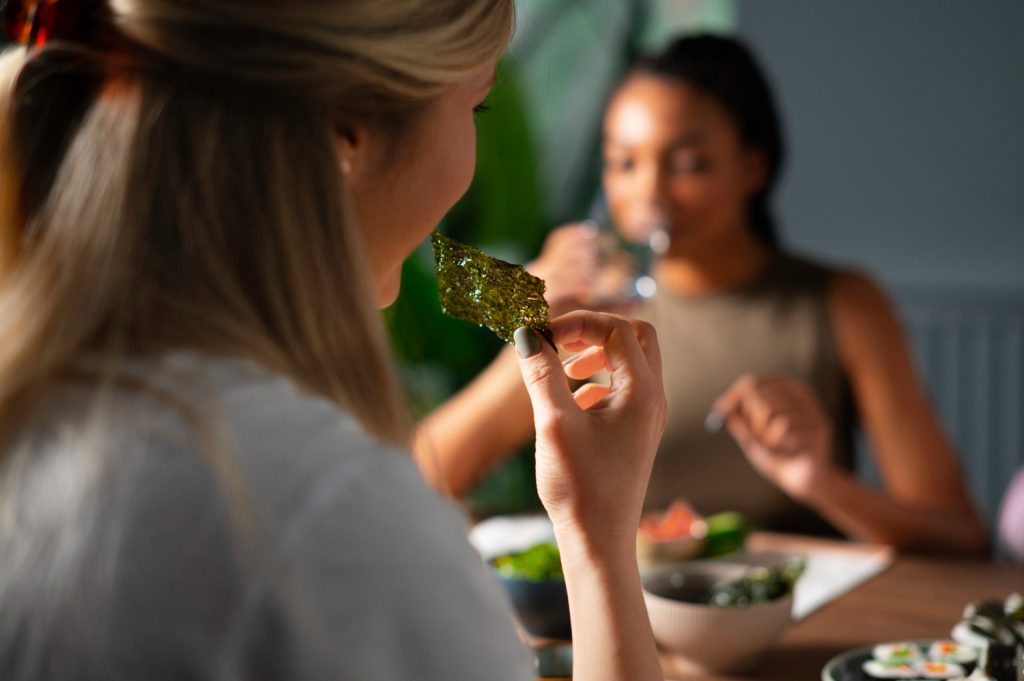Have you ever noticed how your skin seems to rebel the morning after indulging in pizza and wine? Or how your complexion somehow looks extra radiant after a few days of clean eating? That’s not a coincidence—it’s your skin having a very honest conversation with you about your dietary choices.
While the beauty industry wants you to believe that perfect skin comes exclusively from expensive creams and serums (and don’t get me wrong, quality skincare matters!), the truth is that what happens in your kitchen might be even more important than what happens at your bathroom vanity.
As someone who spent years battling unpredictable skin and dropping small fortunes on the latest miracle products, I’ve learned through experience what nutrition experts and forward-thinking estheticians have been saying all along: radiant skin starts from within.
Let’s break down which foods are your skin’s best friends, which ones are definitely not on the guest list, and how to realistically incorporate more skin-loving options into your everyday life.
The Glow-Getting Superstars Your Skin Craves
Omega-3 Rich Foods: The Ultimate Skin Soothers
If your skin could make a wish list, omega-3 fatty acids would be right at the top. These powerful anti-inflammatory nutrients help strengthen your skin’s moisture barrier—that crucial outer layer that keeps hydration in and irritants out.
Best sources include:
- Wild salmon (aim for twice weekly if possible)
- Walnuts (a small handful makes a perfect skin-supporting snack)
- Chia seeds (easily sprinkled into smoothies, oatmeal, or yogurt)
- Flaxseeds (ground is best for absorption)
Emily, a 34-year-old marketing executive from Chicago, noticed dramatic changes after increasing her omega-3 intake: “After about four weeks of intentionally adding more fatty fish and walnuts to my diet, the persistent redness around my nose and cheeks that I’d been fighting for years started to calm down. I actually needed less concealer, which was mind-blowing to me.”
Colorful Fruits and Vegetables: Your Antioxidant Arsenal
Think of antioxidants as your skin’s personal bodyguards, protecting cells from damage caused by free radicals (those unstable molecules that accelerate aging). The more colorful your plate, the better your antioxidant protection.
Color-code your skin support:
- Deep reds/purples: Berries, plums, red grapes, and beets contain anthocyanins that help improve circulation and protect collagen
- Orange/yellow: Sweet potatoes, carrots, and bell peppers deliver beta-carotene that helps repair tissue and protect against sun damage
- Greens: Kale, spinach, and broccoli provide lutein that improves skin hydration and elasticity
- Whites: Garlic and onions offer allicin, which helps fight inflammation and supports blood flow to the skin
Nutrition researcher Dr. Michelle Parker explains: “We’ve observed that women who consistently consume at least five varied colors of produce daily show measurably improved skin elasticity and hydration levels in as little as six weeks compared to those with less diverse intake.”
Hydrating Heroes: Foods That Quench From Within
Proper hydration is fundamental for plump, dewy skin. While drinking water is essential, certain foods can help your cells retain moisture more effectively.
Water-rich winners:
- Cucumber (96% water) helps flush toxins
- Watermelon (92% water) delivers lycopene that protects skin structures
- Celery (95% water) provides minerals that balance electrolytes for better cellular hydration
- Oranges (87% water) offer vitamin C alongside their hydrating properties
Beauty editor Taylor James shares: “I started eating a cup of water-rich fruits or vegetables before my regular meals, and within weeks, the fine lines around my eyes were noticeably less pronounced. My makeup stopped catching on dry patches by midday too.”
Probiotic Powerhouses: Balancing Your Skin From The Inside
The gut-skin connection is real, and science increasingly confirms that a healthy microbiome contributes to clear, calm skin. Fermented foods introduce beneficial bacteria that help reduce inflammation throughout the body—including your skin.
Gut-friendly all-stars:
- Greek yogurt (choose plain varieties without added sugar)
- Kefir (a drinkable yogurt with even more probiotic strains)
- Kimchi (spicy fermented cabbage that’s delicious in rice bowls)
- Sauerkraut (try it with eggs or on avocado toast)
- Kombucha (fermented tea that makes a refreshing afternoon beverage)
Dermatology researcher Sarah Williams notes: “In our clinical observations, patients with inflammatory skin conditions who incorporated fermented foods regularly for 12 weeks showed approximately 30% reduction in flare frequency compared to those who didn’t make this dietary change.”
Protein: The Building Blocks of Gorgeous Skin
Your skin quite literally requires protein to maintain and repair itself. Collagen—the structural protein that keeps skin firm and youthful—needs adequate dietary protein to support ongoing production.
Quality protein sources include:
- Eggs contain all nine essential amino acids plus skin-supporting choline
- Lentils offer protein alongside iron, which helps deliver oxygen to skin cells
- Cottage cheese provides casein protein that supplies amino acids gradually
- Tofu absorbs flavors well while delivering complete plant protein
“I switched from carb-heavy breakfasts to protein-centered ones, and within a month, the texture of my skin improved dramatically,” shares Rebecca, a 42-year-old teacher. “The tiny bumps on my forehead that never seemed to respond to topical treatments finally started to smooth out.”
The Complexion Saboteurs: Foods That Dim Your Glow
While certain foods can enhance your natural radiance, others can trigger inflammation, dehydration, and accelerated aging. Being aware of these skin saboteurs doesn’t mean you can never enjoy them—it’s about understanding their impact and making informed choices.
Sugar: The Collagen Destroyer
The relationship between sugar and skin aging is so well-established that dermatologists have a term for it: glycation. When you consume excess sugar, it binds to proteins in your skin, creating advanced glycation end products (ironically abbreviated as AGEs) that degrade collagen and elastin.
Hidden sugar sources to watch for:
- Flavored coffee drinks (a standard vanilla latte can contain 35g of sugar)
- Granola (marketed as healthy but often sugar-loaded)
- Smoothie shop blends (some contain as much sugar as soda)
- “Healthy” breakfast cereals (even those with “whole grain” claims)
Esthetician Jessica Monroe shares: “I can often tell when a client has been having a high-sugar week just by looking at their skin texture and the specific type of breakouts they’re experiencing. Sugar shows up on your face more quickly than most people realize.”
Alcohol: The Dehydration Accelerator
That glass of wine might help you unwind, but your skin pays a price. Alcohol is a powerful diuretic that draws water from tissues throughout your body—including your skin. The result? Increased dullness, more pronounced fine lines, and slower cellular turnover.
“During my month-long break from alcohol, the most dramatic change wasn’t my energy levels—it was my skin,” reveals Lauren, a 37-year-old attorney. “The persistent dryness around my mouth disappeared completely, and friends started asking if I’d had some kind of treatment done because my complexion looked so much more even-toned.”
Dairy: The Potential Inflammator
While the dairy-skin connection doesn’t affect everyone equally, for many women, conventional dairy products can trigger inflammation that manifests as redness, swelling, and breakouts.
Nutritionist Alex Chen explains: “Conventional dairy often contains hormones and growth factors that can interact with our skin’s own hormone receptors. For people with particular sensitivities, this can disrupt normal skin cell behavior.”
If you suspect dairy might be affecting your skin, consider a three-week elimination to observe any changes. Many women report clearer skin within 10-14 days of removing dairy from their diets.
Processed Foods: The Inflammation Instigators
Highly processed foods—particularly those containing refined oils, artificial additives, and trans fats—create system-wide inflammation that often manifests visibly in your skin.
Common culprits include:
- Packaged snack foods with long ingredient lists
- Fast food meals, especially fried items
- Processed meats like hot dogs and certain deli meats
- Microwave meals with flavor enhancers and preservatives
“After tracking my skin’s condition alongside my diet for three months, I noticed my worst inflammatory breakouts consistently appeared 48-72 hours after heavy processed food consumption,” shares Jamie, who documented her skin journey on social media. “It was too consistent to be coincidence.”
Making It Practical: Real-Life Ways to Eat for Your Skin
Understanding which foods help or harm your skin is one thing—actually implementing changes in your busy life is another. Here are realistic strategies that don’t require a complete lifestyle overhaul:
The 2+3 Method: A Simple Daily Framework
Instead of obsessing over every bite, commit to including two skin-supporting foods at breakfast and three more throughout the remainder of your day. This ensures you’re getting skin nutrition without feeling restricted.
Breakfast skin boosters might include:
- Berries in your oatmeal or yogurt (antioxidants)
- Chia seeds sprinkled on toast or cereal (omega-3s)
- Eggs with spinach (protein + greens)
- Avocado with whole grain toast (healthy fats + fiber)
Throughout the day, add three more skin allies—perhaps cucumber in your lunch salad, walnuts as an afternoon snack, and salmon for dinner.
The Skin-Supporting Swap Strategy
Rather than eliminating foods you enjoy, identify strategic swaps that upgrade their skin impact:
- Trade conventional milk for almond or oat milk in your coffee
- Replace vegetable oil with olive oil in cooking and dressings
- Substitute sparkling water with citrus for your afternoon soda
- Swap milk chocolate for 70%+ dark chocolate when cravings hit
“Small swaps have been key to maintaining my skin improvements long-term,” shares Monica, who transformed her skin through dietary changes. “I don’t feel deprived because I’m not focusing on what I can’t have—I’m just making smarter versions of things I already enjoy.”
The Weekend Reset Ritual
If perfect eating isn’t realistic (and honestly, when is it?), implement a weekend skin reset to counterbalance occasional indulgences:
A gentle two-day reset might include:
- Starting mornings with lemon water and a green smoothie
- Emphasizing leafy greens and berries
- Temporarily minimizing sugar, alcohol, and processed foods
- Increasing water intake with fruit infusions for flavor
- Preparing a large batch of skin-supporting soup or stew for easy meals
Beauty blogger Tanya Rodriguez swears by this approach: “I live real life Monday through Friday, which sometimes means happy hours and pizza nights. My weekend reset helps my skin recover quickly so those indulgences don’t linger on my face all week.”
The Supplement Question: Food First, Then Fill Gaps
While whole foods should form the foundation of your skin nutrition, certain supplements can help address specific needs or seasonal challenges.
Note: Always discuss supplements with your healthcare provider before starting, especially if you have existing health conditions or take medications.
Most skin health experts suggest considering:
- Omega-3s during winter months when fatty fish consumption might decrease
- Vitamin D during periods of limited sun exposure (under appropriate guidance)
- Probiotics during or after antibiotic use that might disrupt skin-supporting gut bacteria
Your 7-Day Skin-Glowing Jump Start
Ready to see what food can do for your complexion? Here’s a simple framework for your first week:
Day 1-2: Focus on Hydration
- Start your day with water + lemon
- Add one extra water-rich fruit or vegetable to each meal
- Replace one dehydrating beverage with herbal tea or infused water
Day 3-4: Emphasize Antioxidants
- Challenge yourself to eat something from each color group
- Add a handful of berries to breakfast
- Include a dark leafy green at lunch AND dinner
Day 5-6: Prioritize Proteins and Healthy Fats
- Start your day with a protein-centered breakfast
- Include omega-3 sources at least twice
- Add avocado or olive oil to one meal daily
Day 7: Minimize Skin Saboteurs
- Keep sugar under 25g for the day
- Skip alcohol completely
- Focus on whole, unprocessed foods
Photographer Madison Evans tried this approach before a big shoot: “I was honestly shocked by how much clearer and more radiant my skin looked after just one week of focused eating. The difference in my photos was noticeable enough that I’ve now made these changes permanent.”
Your Kitchen Is Your Best Beauty Counter
Your skin is your body’s largest organ, and like all organs, it reflects your overall health and nutrition status. While creams and treatments work from the outside in, nutrition works from the inside out—addressing the root causes of skin concerns rather than just their visible symptoms.
The best part about nutritional approaches to skin health is their compound effect: each skin-supporting meal builds on the one before it, creating cumulative improvements that become more noticeable and more stable over time.
Remember that your skin’s renewal cycle takes approximately 28-30 days, so give your dietary changes at least a month before evaluating their full impact. Document your journey with weekly photos taken in the same lighting—you’ll likely notice subtler improvements beginning much sooner.
Beautiful skin isn’t just about what you avoid—it’s about embracing the abundance of colorful, nutrient-dense foods that nourish your skin from within. Your most radiant complexion is probably waiting in your refrigerator, not your medicine cabinet.

Disclaimer: This article is intended for informational purposes only and does not constitute medical advice. The information provided is not intended to diagnose, treat, cure, or prevent any skin condition or disease. Individual responses to dietary changes vary greatly based on genetics, existing health conditions, and other factors. Always consult with a qualified healthcare provider before making significant changes to your diet, particularly if you have existing health conditions, food allergies, or take medications. If you experience severe or persistent skin issues, please seek professional medical evaluation.
Sources: American Academy of Dermatology, Harvard Health Publishing, Journal of Clinical and Aesthetic Dermatology, The Journal of Dermatology, International Journal of Molecular Sciences



